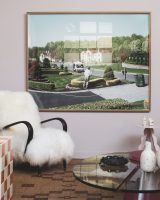
PHOTO Spaces—Le Space with Ying Ang
15.9.21
Following the launch of her critically acclaimed photobook The Quickening, the Melbourne-based photographer, gallery owner and author tells us about Le Space, her artistic process and inspiration. Learn more about this incredible photographer and why she launched a gallery and agency in Collingwood to promote the work of other photographers.
Hello Ying, please start by telling us something about yourself that is not in your bio.
I began my education in Applied Sciences and never really considered myself a creative person through school. It wasn’t until I really began to understand photography as a conduit for ideas that it began to make sense as an essential way for me to process difficult experiences and concepts. This is when I really found my footing as a photographer. It wasn’t until psychology, history, criticism and hypothesis became a part of my process that I could forgo the sense of imposter syndrome that dogs so many people in the art space. In a way, this is not so divorced from the process that fuelled my interest in the sciences so early in my academic career.
Can you explain your artistic processes to us (research, methods, processes, rituals, etc)? Has this changed over time?
My artistic process usually begins, simply enough, with pictures. I am photographing intuitively a lot of the time. I believe that the process of photographing intuitively speaks to the magic that can happen with the break in time and imagination that happens with shooting film—where the image is conjured in the mind and made before it is seen in reality with some time to percolate in-between. Upon assessment of the images later on, I allow my cognitive process to begin where I look at where my intuition is pointing me and begin the exploration that comes with curiosity and more importantly, a questioning. This then turns into a process of discovery and further questioning, which then becomes a process of hypothesis building. The end result is structured as a visual thesis, often in book form, that also builds in the crucial elements of ambiguity and intentional questioning often present in successful, critical art.
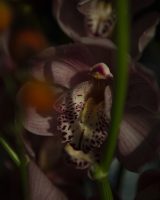
Ying Ang, The Quickening (2021)
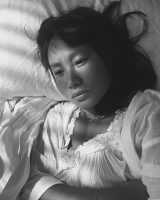
Ying Ang, The Quickening (2021)
What led you to photography in the first place?
I began writing creative prose and poetry very early in my life and continue to do so now. Probably from the age of 6 onwards. Photography didn’t come to me until my father gave me my first camera when I was 22 and about to embark on my first great overseas adventure alone. Those 2 events collided to open up a way of moving through life that fit better than any other thing I’d ever put my hand to before. I continue to write but that process is still intuitive and not as critical or guided by professional practice as my photography is.
As an artist/creative, where do you draw inspiration for your work from?
I draw my inspiration from a variety of sources that outwardly present as eclectic but all lead back to a purposely intent and obsession with contemporary culture. I am very curious about the choices that we make as a species about the way that we live, how those choices are influenced by our environment and whether there might be a more beneficial and considered approach. What are our blindspots and what is at risk when we ignore them? The inputs to this can range from literature, historical documents, cinema, reality television and personal experience.
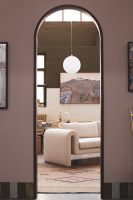
Le Space, Collingwood, Victoria
You opened Le Space in September 2019, what prompted you to open this venture in Melbourne?
Le Space began quite simply with me looking for a studio space to work in and my partner, Michael Chazan, looking for a new atelier to design and make furniture. Timing-wise, it made sense for us to find a place together and after looking for a while, we stumbled across this saw-tooth warehouse with great light and fell in love. The only obstacle was that it was far too big for just the two of us. We decided to subdivide the area to allow for other creative people to tenant the space too, and perhaps build a little creative community where we didn’t work in a vacuum of just the two of us, which we were already doing at home with a baby!
The warehouse was still big enough after the subdivision to allow for a gallery space and I really felt like there was an under-representation of highly collectable and mid-career international photographers in Melbourne—which is my discipline and professional community. There is a lot of support of local talent and I feel that as a vibrant and metropolitan city, we are lacking in the exciting dynamic that happens when there is a free flowing discourse between people in the arts from different countries around the world. Given that I built my career in both Europe and the Americas, I thought that it could be good to leverage those contacts and give them a platform here in Australia to show and sell work, in addition to bringing them over with an artist-in-residency program and provide the artistic community here an opportunity to engage in a sharing of skills and ideas.
Le Space is not your average gallery and studio space. What makes Le Space special?
We are a community space with a cross-section of design and art practitioners tenanting our studios, using our gallery to showcase their concepts, in addition to exhibiting work from the wider arts industry in Australia and a selection of people from overseas. We like to think of ourselves as being unbound by geography and category and be influenced more by ideas. Exciting experiences in the arts come from a wide variety of sources. Sometimes it is grassroots storytelling, sometimes it is a celebration of iconic works, sometimes it is beauty and sometimes it is politics. Le Space is a private gallery run by myself and my partner, Michael Chazan, who is a furniture designer, and therefore we have the luxury of being audacious with our decision making and curation in that way.
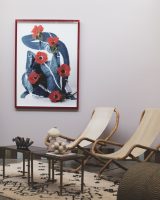
Le Space, Collingwood, Victoria
It’s such a beautiful space, but also one that has a great functionality and flexibility. You designed this in collaboration with Flack Studios, what led the collaboration through the design process? How did you see your vision being played out with the design and build of the space?
The inspiration behind the collaboration came from an interrogation of the white wall gallery vs the way creative salons would function in the Paris of Gertrude Stein. We are interested in ideas and cultivating a culture of connecting artists with lovers of art, artists in Australia with artists overseas, artists with the artistic ecosystem of curators and collectors. We wanted the gallery equivalent of a vibrant dinner party where you could be exposed to fierce opinion and perhaps leave, a changed person, emotionally or intellectually. This makes the space more about cultivating an atmosphere of creativity and warmth than the idealised notions of contemporary gallery spaces. Its design objective was the physical spatial manifestation of a crucible where old ideas can be integrated with contemporary ones.
Your studios have a great array of residents across several industries, can you tell us about how the intersectionality of the disciplines informs the community of Le Space?
Le Space is one half me and one half Michael Chazan of Moda Piera… one part photographer and one part furniture designer. In conceptualizing Le Space, it seemed limiting and elementary to assume that people who were interested in design wouldn’t be interested in art and vice versa. As individuals, Michael and I straddle both the design and art world quite seamlessly and it makes for a richer creative life. Le Space began and still is a space of experimentation along this ethos. Our current creative ecosystem is composed of architects, interior designers, jewelry designers, curators and photography book specialists as tenants. We are also planning on expanding and building two more studios and looking to add to our community some time next year. It would be interesting to widen the scope a little to disciplines outside what we already have.
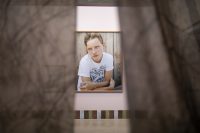
Nanna Heitmann, Hiding From Baba Yaga, installation view Le Space for PHOTO 2021, image by Ying Ang
Alongside your own practice you also represent some amazing photographers. What was it that motivated you to move into representing other photographers?
The photographers that I represent are all my friends. To be honest, the idea to represent people was born on the steps of the Grand Palais during Paris Photo one year during a casual conversation and what was truly a cavalier impulse response on my behalf. I was speaking to a few friends about Le Space and wanting to build a gallery that would be largely supported financially by our tenants, and therefore freeing us up to show work that we truly believed in, instead of balancing our vision against the coercion of financial obligations. Our objective was to be able to showcase interesting work, sell work to aid in the livelihood of artists and contribute to a wider discourse on art, storytelling, photography and design. My friends asked to be guinea pigs in this experiment and trusted me with their work, so here we are! Representing other artists was never really a part of the master plan but I was asked to and essentially, just said yes.
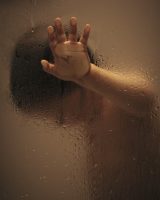
Ying Ang, The Quickening (2021)
![The Quickening Book Ying Ang, from the series [The Quickening].](https://photo.org.au/api/wp-content/uploads/2021/09/THE_QUICKENING_041-160x200.jpg)
Ying Ang, The Quickening (2021)
Why is photography an important artform/practice to engage with (both personally and for others)?
Photography is another language with which to communicate and conceptualise the world that we live in. We have always been story-telling creatures and it is in the telling of stories to each other that we learn and pass on learnings to others across geographical, cultural and generational bounds. It is an evolutionary tool for survival.
What has been the most rewarding project you have worked on so far?
It is hard for me to choose between the 2 largest projects that have dominated my life to date, “Gold Coast” and “The Quickening”. Both were made from a mining of personal experience that was a conceptualising of trauma, both felt successful in a cathartic sense, both have achieved critical accolades and both have been instrumental in furthering my artistic practice for future projects. The difference between the two project is that “Gold Coast” came first, so in that sense, it was the project with the steepest learning curve. There is an adrenaline that comes with doing something so monumental for the first time, so the feeling of reward is higher when the sense of risk is higher.
What do you hope your legacy will be?
I hope that my books exist as critical purveyors of our blindspots that continue to inform generations to come in the dusty old attics of libraries that no one goes to anymore!